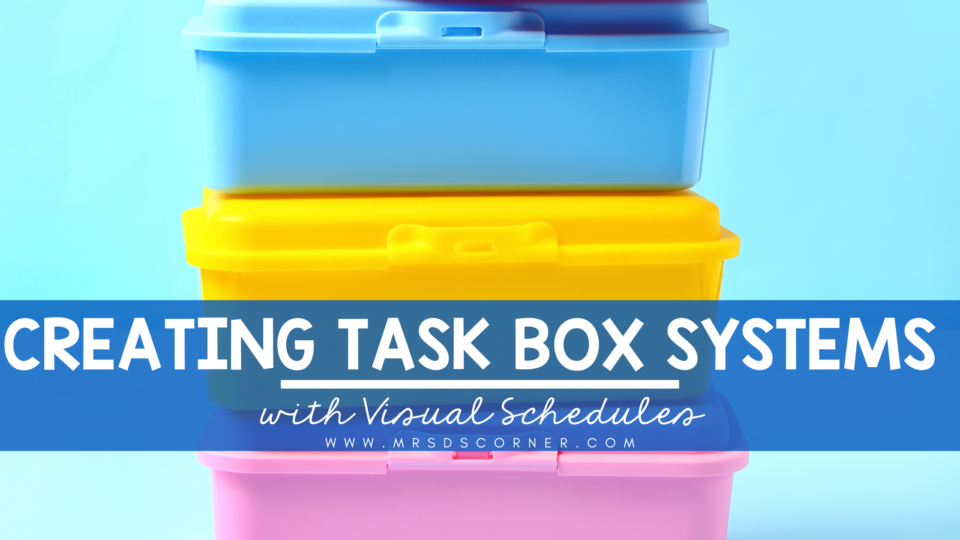Task box systems play a crucial role in special education classrooms by providing students with structured and independent learning opportunities.


These systems consist of individual tasks or activities stored in bins or containers, allowing students to work through them at their own pace. Task box systems are beneficial for students with diverse learning needs as they promote skill practice, generalization, and independence. They also allow teachers to work with other students while knowing that their students who are assigned task boxes have material that is relevant to their needs and ability levels.
Benefits of Task Box Systems
Task box systems aren’t just beneficial for teachers; they’re also very helpful for students. What can they do? Well, they do a lot beyond just providing work. Here are some of the things that make them so beneficial.
Promoting Independence
Students can work autonomously on assigned tasks, fostering self-reliance and confidence. Teaching students in special education how to work independently is a valuable skill, and task boxes can help with that.
Skill Practice
Task boxes offer targeted practice in various skills, such as fine motor skills, matching, sorting, and more. Task boxes can even be tailored to help students practice their IEP goals.
Generalization
Students can transfer learned skills to different settings and situations, promoting the generalization of knowledge. This sounds like a no-brainer, but when students can work independently and transfer skills, that is a sure sign of leveling up their abilities and education.
Classroom Management
Task box systems help streamline classroom routines and provide structure for both students and teachers. Students, especially those in a special ed classroom, need that structure and routine. Task boxes can help.
This video will help explain more about and give examples of task boxes and work bins for your students.
Don’t feel like making your own task boxes or don’t have the time to come up with ones right away? Check out this huge collection of task boxes that are just waiting for you to print and assemble!
Using Visual Schedules with Task Box Systems
Visual schedules are a natural complement to task box systems, enhancing the organization and effectiveness of independent learning activities. Visual schedules use visual cues such as pictures, letters, numbers, or colors to represent tasks and guide students through their daily routines. When integrated with task boxes, visual schedules provide clear instructions, promote understanding of expectations, and support students in completing tasks independently.
Why Visual Schedules Work Well
Visual schedules work well for depicting the schedule for the day, but they are also very helpful for scheduling task boxes. Basically, they tell students which boxes to work on so that they can progress through their assignments pretty much independently. Here are some more benefits of using visual schedules with task boxes.
Clarity
Visual cues offer clarity and predictability, helping students understand what is expected of them.
Engagement
Visual schedules engage students by making tasks more visually appealing and accessible.
Differentiation
Visual elements cater to diverse learning styles, ensuring that all students can access and comprehend the schedule.
Consistency
Visual schedules provide a consistent framework for students to follow, promoting routine and structure.
Creating Effective Visual Schedules for Task Box Assignments
To create a visual schedule that aligns seamlessly with task box assignments, teachers can use a variety of visual elements to enhance student understanding and engagement. Incorporating letters, numbers, pictures, and colors into the visual schedule can make the learning experience more interactive and meaningful for students. Remember, the key is that the labels on the task boxes must match the labels on the child’s visual schedule.
Strategies for Creating Visual Schedules for Task Boxes
Labeling with Letters or Numbers
Assigning a letter or number to each task box and corresponding it with the student’s schedule provides a clear matching system. For example, Task Box A corresponds to Schedule Item A.
Using Pictures
Including pictures representing each task or activity helps students visualize the assignment and understand what is expected of them. For instance, a picture of blocks for a sorting activity could correspond to the label on the front of the blocks bin.
Color Coding
Organizing tasks by color can help students differentiate between subjects or levels of difficulty. For instance, all math-related tasks could be color-coded in blue. You could even differentiate further by making different blue symbols for each math task box. Shapes are especially good for this as they help reinforce the name of the shape, color, and subject matter.
Color coding could also encompass the color of the bins. So, a blue “1” card on the visual schedule could mean that the student must work on the blue bin with the number 1. This really opens up the possibilities for a lot of work bins and may work well for a highly differentiated class.
By implementing visual schedules that align with task box systems, teachers can enhance student engagement, promote independence, and create a more organized and efficient learning environment in special education classrooms. They’re not that difficult to set up, and once you have them completed, they’re great to use all school year long!

